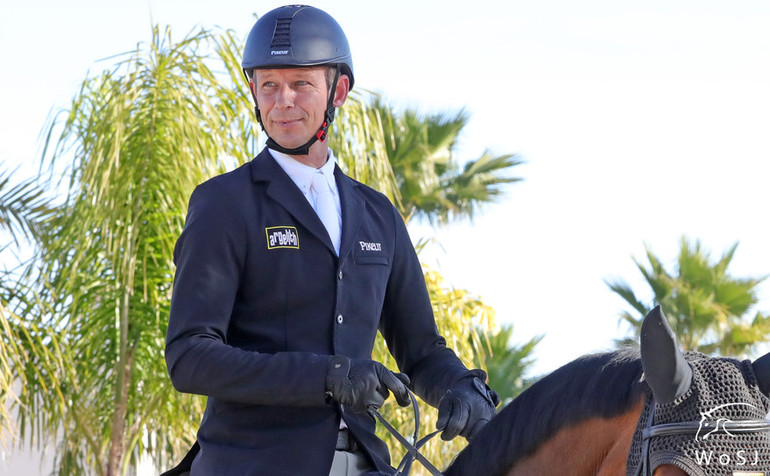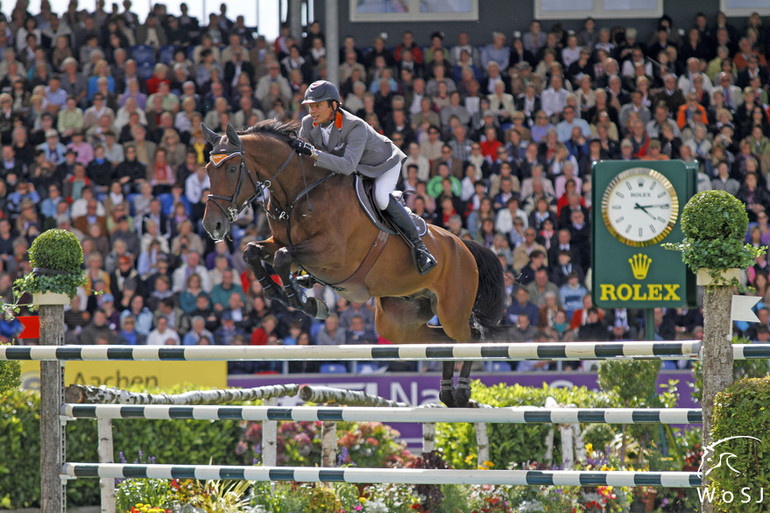Text © World of Showjumping
WoSJ sat down with Marco Kutscher with one question: “What is good riding?” and ended up having a long conversation about the importance of dressage, horsemanship, ending 5th, back boots, horses’ exteriors, selling to live and today’s top sport.
Good riding is about adjusting
According to Kutscher, good riding is a subject you can philosophize a lot on. “Basically, it is about finding a solution together with your horse,” Kutscher begins. “The horse and the rider have to find the best possible and most successful way to work together – it has to be a partnership. There are several ways of riding well and many different training methods that work though. Personally, I think what recognises a good rider is when he or she can adjust to different kind of horses with various approaches and as such make it possible to be successful.”
Kutscher himself prefers the German educational system where the dressage work is a big priority.
It is not like we can do it better than anyone else, but we put great importance on the dressage work and that really matters to me.
“I believe that sport horses, and especially those on the highest level, need the gymnastics they get through dressage work to stay sound over a longer period of time. For sure you can improvise and compensate a lot with the huge variety of different bits available today – but nothing can replace the balance and the muscles as well as the flexibility the horses need to handle the workload. A horse can only gain this through solid and classical dressage work. Furthermore, good dressage work is essential for the riders when they are in the ring.”
Look at your colleagues
Even a rider like Kutscher has other riders he looks up to. “For example, I’m a fan of Daniel Deusser. The way he can adapt to different kind of horses – always stylistic – and build them up to the highest level is something I admire. On one side he is determined, and on the other side he is always with the horse – that is for me the optimal riding,” Kutscher says. “Then we have Marcus Ehning that has a completely different style of riding – also much due to having another body size than Daniel for example – that just has been great to watch for years. And we have the current in-form Julien Epaillard that has yet another way of riding, and who sweeps his competitors off the floor like no one else for the moment.”
“It is always interesting to look at how my colleagues are doing it,” Kutscher continues. “We all ride differently, but in the end, we somehow get the same out of it. There are several riders I like to watch, and where I try to take something with me. In general, I think it is important for riders not to get too focused on themselves but instead look at what others are doing. There is always something you can take with you to try and see if it works for you.”
The art of riding
Daniel Deusser, Marcus Ehning and Julien Epaillard all make it look so easy, but is it really that easy we ask Kutscher? “It is a lot of work behind the easy look,” he says. “From nothing you get nothing. You have to work hard to get there, but it is all about the way of getting there. One rider does it with a phenomenal feeling, and another might do it in a more intense way to in the end make it look easy."
The light look does not come by itself; you have to work your horse to get there and watching some riders I have to say even their work of getting there looks easy. That is the art of riding and the riders I mentioned all master this art.
“Every now and then, I would also like to know more about how to make it look so easy, but in this sport we never get fully educated,” Kutscher says. “You can speak with many riders and all of them will say that the older they get the more they realise they could have done things differently to optimize the riding even more – when looking back at horses they have had. A rider will never know it all, because with living animals there will always be something new, always be a challenge and that is what makes our sport so exciting.”
A different time
Over the last few years, Kutscher has witnessed first-hand how the sport has gone through a huge change. “What I achieved was in a different time,” he says. “If I came back to the top sport today, I’m not sure doing what I did in the past would be possible again – that is how much the sport has changed. The level on the good riders is so much closer now, as is the level on the management.”
“Since last year, it’s also been extreme due to the pandemic. You can find the best riders and their top horses at a two-star show, which has made it extremely difficult for a lower-level rider to have success. With the bigger shows being cancelled, the level at the two-star and three-star shows has been raised,” Kutscher says.
“In general, everything has gotten so much faster and the level so much higher,” Kutscher continues.
As it is now, I feel sorry for the course designers that are doing their job week in and week out. What more can you build?
"The level we have at five-star shows today is just incredible. Just the demands during those courses where the riding has to be perfect and with a short time allowed on top, and there are still hardly any faults. I don’t want to say that the new hind boots rules will change everything, but I think that we with regulations like that can stay on the same level of difficulty – that the courses don’t have to get even more extreme. They are challenging enough as they are.”
“I’m happy I had a good time in the top sport when I did; now I try to participate here and there,” Kutscher says. “To get back to the top is difficult enough and, in the end, the good horses will have to be sold to finance it all. With that in mind, my current focus is on the educational aspect of the sport. I’m happy with that though, nevertheless I think it is exciting to see how the sport develops.”
“I had the luck to be a part of the five-star circuit for years, and of course I would like to get back up there,” Kutscher smiles. “As it is now, I’m far from the top. If I would get the possibility of getting a good horse or to keep a horse of my own for longer, I would be happy to give it another go though,” Kutscher continues. “I have horses in the stable that are better than most, but if they are good enough for the top sport – then I’m talking about championships – I don’t know. We have bought a very interesting young horse that really keeps me motivated, but until she is ready for anything bigger it will take 3-4 years and in that time a lot can happen. First of all, she might be sold already, then there is the health and you also need a bit of luck – there are so many things that need to come together for her to become a real top horse.”
The mind is what matters
Kutscher explains that while a top horse needs many qualities, the mind is what matters the most to him. “If the horse has the will, you can achieve a lot through good work. You can have the biggest talents in the stable, but if they get in the way of themselves and they don’t fight along it is really difficult,” Kutscher says. “For me the head of a horse is what decides if it will be a top horse or not. Of course, they need quality, and they need to be careful, but a lot of horses have that now a days – so in the end it is the mind that matters.”
What about the horses’ exteriors, we ask? “A good exterior will of course make it easier for the horse. I have had a lot of horses in my life though, where the different parts of the body really didn’t fit together – and they were still sensational horses,” Kutscher says. “Cash is one example – if you saw him without a saddle you just shook your head and thought that a horse with that body would never last in the sport. He was long, stiff, the hips were crooked and there were a lot of other things too. Despite his body, Cash was a dream horse that competed until he was 17. He is still doing well and is moving great in the field of his owner Mrs. Winter-Schulze. Cash just had such a fantastic attitude towards the sport.”
All about horsemanship
Our conversation then moves on to sustainability. “When we talk about sustainability, it is so much more than high fences that plays a part,” Kutscher points out. “The surfaces that we constantly ride on, and the way a course designer builds a jump-off are examples. A course designer can include special turns that put an extreme strain on the horses – this is a question about the course designer’s finesse. Then it is also about the feeling of the person who is making the surface, how solid the ground will be to give the horses grip but without making it so compact that the horses' health is at risk. There are so many different components that affect the sustainability of the horses and in the end, it is up to the rider to decide if they want to go for it or not."
Sometimes the rider will decide not to give everything, and rather end up in 5th or 6th place instead – but with a horse that hopefully was saved a little. In the end, it is all about horsemanship.
“I believe that we still have horsemanship in the sport,” Kutscher says. “Of course, there will always be some that don’t care so much but I think there are many real horse people out there. They know how important the horses they ride on are and those horses are often also their capital – so if you see a rider that doesn’t give everything in a jump-off, that might be just the reason.”
“In a young person’s life, the early focus will often be on winning,” Kutscher says. “However, with time, they will learn that every now and then, they will have to take a step back for the sake of the horse. To learn good horsemanship takes time.”
No reproduction without written permission, copyright © World of Showjumping










